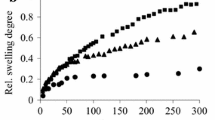Abstract
The influence of water on the physical properties of a hydrogel is important for understanding natural tissues and in designing synthetic materials to replace them. In this study, poly (2-hydroxyethyl methacrylate) (pHEMA) was used as a model system to understand how water interacts with the polymer of a hydrogel. Thermal analysis methods (thermogravimetric analysis coupled to mass spectrometry and differential scanning calorimetry) were used to determine: (i) the total water content of pHEMA gels; (ii) how this water was lost during heating; (iii) the relationship between water content of the gel and its glass transition temperature; and (iv) the behavior of the water in the gel on cooling. Previous researchers have invoked various models to describe the organization of water in a hydrogel. In this study, the simplest model which could explain all of the results from the different thermal analysis techniques was one which consisted of three classes of water: (i) hydration water in close proximity to the polymer; (ii) interstitial water in regions or cavities surrounded by polymer chains; and (iii) bulk water.
Similar content being viewed by others
References
V. J. Mcbrierty, S. J. Martin and F E. Karasz, J. Mol. Liq. 80 (1999) 179.
H. B. Lee, M. S. Jhon and J. D. Andrade, J. Colloid Interface Sci. 51 (1975) 225.
D. G. Pedley and B. J. Tighe, Brit. Polym. J. 11 (1979) 130.
H. Xu, J. K. Vij and V. J. Mcbrierty, Polymer 35 (1994) 227.
G. Smyth, F. X. Quinn and V. J. Mcbrierty, Macromolecules 21 (1988) 3198.
L. Fambri, C. Gavazza, M. Stol and C. Migliaresi, Polymer 34 (1993) 528.
L. Bosio, G. P. Johari, M. Oumezzine and J. Teixeira, Chem. Phys. Lett. 188 (1992) 113.
W. E. Roorda, A. B. Johanna, M. A. De Vries and H. E. Junginger, Pharm. Res. 5 (1988) 722.
J. Rault, A. Lucas, R. Neffati and M. Monleon Pradas, Macromolecules 30 (1997) 7866.
R. Wolfson and J. M. Pasachoff. “Physics with Modern Physics for Scientists and Engineers”, 2nd edition (HarperCollins College Publishers, New York, 1995) p. 489.
W. E. Roorda, A. B. Johanna, M. A. De Vries and H. E. Junginger, Biomaterials 9 (1988) 494.
Y. M. Sun and H. L. Lee, Polymer 37 (1996) 3915.
J. M. G. Cowie, “Polymers: Chemistry & Physics of Modern Materials”, 2nd edition (Blackie, Glasgow, 1991) p. 329.
P. Jenniskens and D. F. Blake, Astrophys. J. 473 (1996) 1104.
Y. Maeda and H. Kitano, Spectrochim. Acta. A 51 (1995) 2433.
S. Utoh, J. Chem. Phys. 115 (2001) 601.
C. A. Angell, in “Water, a Comprehensive Treatise”, volume 7, edited by F. Franks (Plenum Press, New York, 1982) p. 1.
Author information
Authors and Affiliations
Corresponding author
Rights and permissions
About this article
Cite this article
Meakin, J.R., Hukins, D.W.L., Imrie, C.T. et al. Thermal analysis of poly(2-hydroxyethyl methacrylate) (pHEMA) hydrogels. Journal of Materials Science: Materials in Medicine 14, 9–15 (2003). https://doi.org/10.1023/A:1021589017753
Issue Date:
DOI: https://doi.org/10.1023/A:1021589017753




